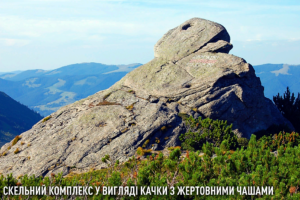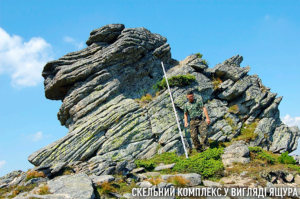Calendar sanctuary in Chornohora
At the end of July 2007, an expedition to Chornohora was organized in the composition of professor M. Kugutyak, associate professors B. Khruslov, M. Vitenko, senior teachers R. Kobylnyk and T. Malanyuk. Its purpose was to identify, describe, and map rock petroglyph complexes in the Gadzhina plain, the Kedruvaty, Shpytsy, Rebra, Brebeneskul, Chorna Gora, Smotrych, and Vukhatiy Kamin mountains. On the last day of the expedition, on July 27, 2007, the survey of Mount Vukhatiy Kamin and the discovery of rock petroglyphic complexes and three-dimensional sculptures on it left no doubt that the temple described by al-Masudi on Chornohora had been found.
One of the most informative is the rock complex No. 9, which has the name “Frog”. Stone-frogs are a common phenomenon in the rock sanctuaries of the Carpathians (the village of Roztoky, the village of Marynychi). V. Danylenko, on the basis of a wide range of archaeological sources of South-Eastern Europe, concluded about the existence in ancient times of a special symbol of the earth endowed with the characteristics of a frog. This exclusively archaic, mainly Southern European image of the Great Mother, the Earth, dying and resurrecting nature has been preserved to this day in folk art in the form of flat “frog” motifs of Hutsul embroidery.
Rock complex No. 9 has the generalized appearance of a frog. Its height is about 6 m, width – 15 m. On one of the ledges, a three-dimensional left profile image of a bull’s head, 2 m high, is carved into the rock and polished, facing northeast, in the direction of the sunrise on the day of the summer solstice. The diameter of his round eye with a moon-shaped lid reaches more than 50 cm and the depth is 15 cm. A round, flat-bottomed depression is made on his forehead, the muzzle and horns are highlighted, and a linear-angular band is drawn near the eye.


